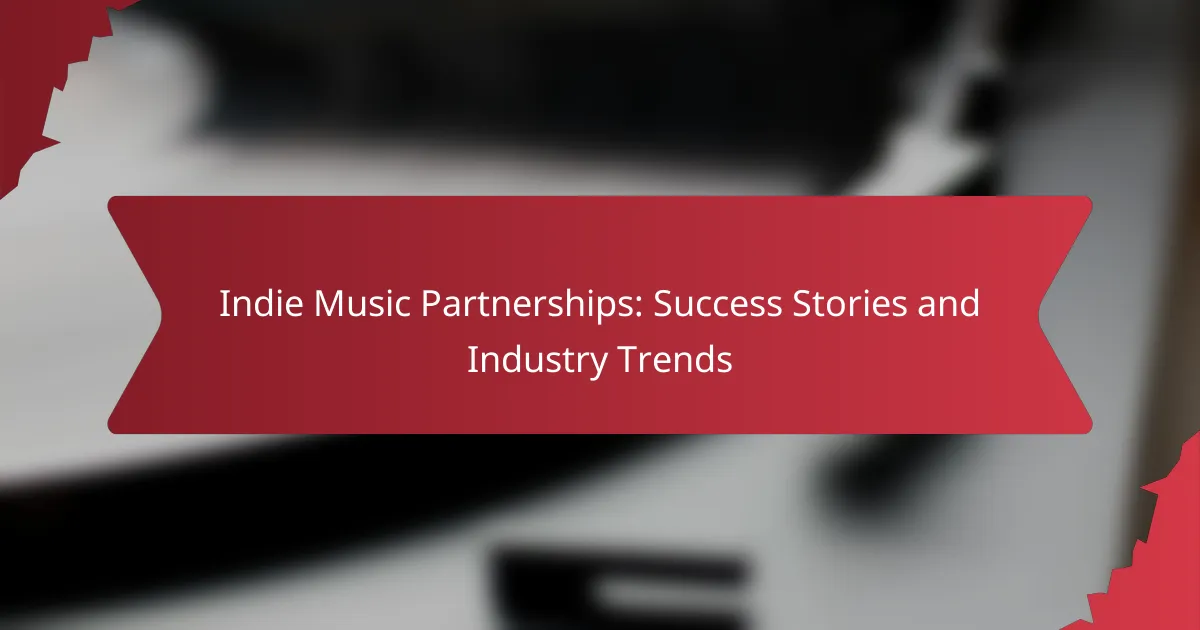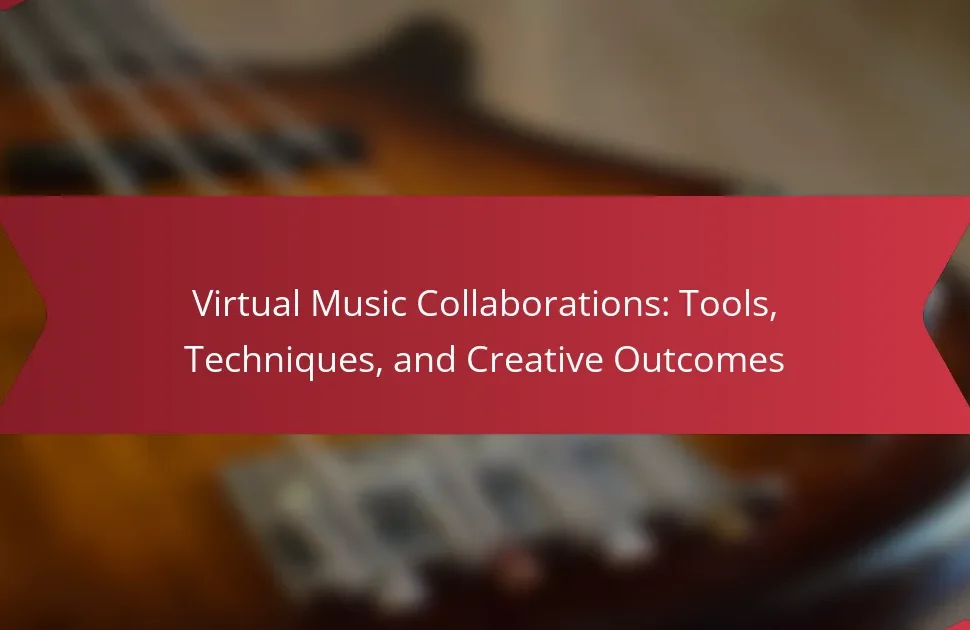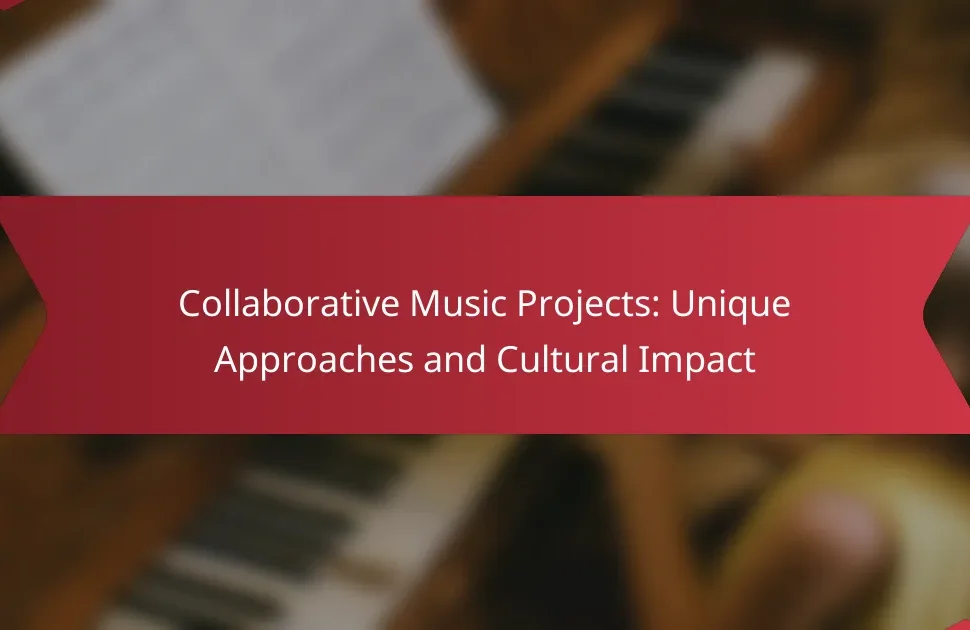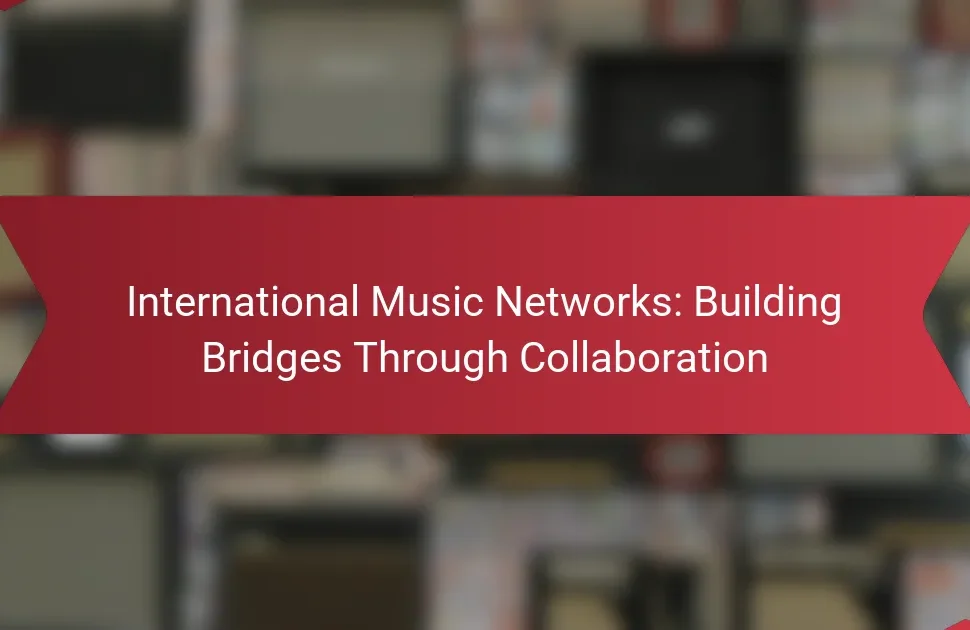Indie music partnerships provide artists with increased exposure, creative collaboration, and access to essential resources. This article explores notable success stories, regional variations in collaboration, the impact of technology, common pitfalls, and emerging industry trends. Discover how these partnerships are reshaping the music landscape and driving innovation.

What are the key benefits of indie music partnerships?
Indie music partnerships offer artists increased exposure, creative collaboration, and access to diverse resources. These partnerships can enhance marketing strategies, allowing for a broader audience reach and shared promotional efforts. Collaborations often lead to unique sound explorations, fostering innovation in music. Additionally, indie partnerships can provide financial support through shared funding, enabling artists to invest in projects that may otherwise be unattainable.
How do collaborations enhance artist visibility?
Collaborations significantly enhance artist visibility by expanding their audience reach. When indie artists partner with others, they tap into each other’s fan bases, increasing exposure. For example, a joint performance or a shared track can introduce an artist to new listeners who may not have discovered them otherwise. These partnerships can also leverage social media platforms, where shared content amplifies engagement and visibility. As a result, collaborations often lead to increased streaming numbers and greater opportunities in the music industry.
What role do partnerships play in revenue generation?
Partnerships play a crucial role in revenue generation for indie music by enhancing visibility and expanding audience reach. Collaborations with brands, venues, and other artists create diverse income streams. For example, joint tours or merchandise can significantly boost sales. Successful partnerships also leverage social media for promotion, increasing engagement and driving ticket sales. These strategies exemplify how indie musicians can thrive in a competitive landscape.
Which marketing strategies are boosted through partnerships?
Collaborative marketing strategies are significantly enhanced through partnerships in the indie music scene. These alliances can amplify reach, diversify promotional efforts, and create unique brand experiences. For instance, artists partnering with brands can tap into new audiences, while labels collaborating with venues can boost ticket sales.
Additionally, partnerships often lead to co-created content, such as music videos or exclusive releases, which can engage fans more deeply. Successful examples include collaborations between indie musicians and lifestyle brands that resonate with their target demographics. These strategies not only increase visibility but also strengthen community ties within the industry.
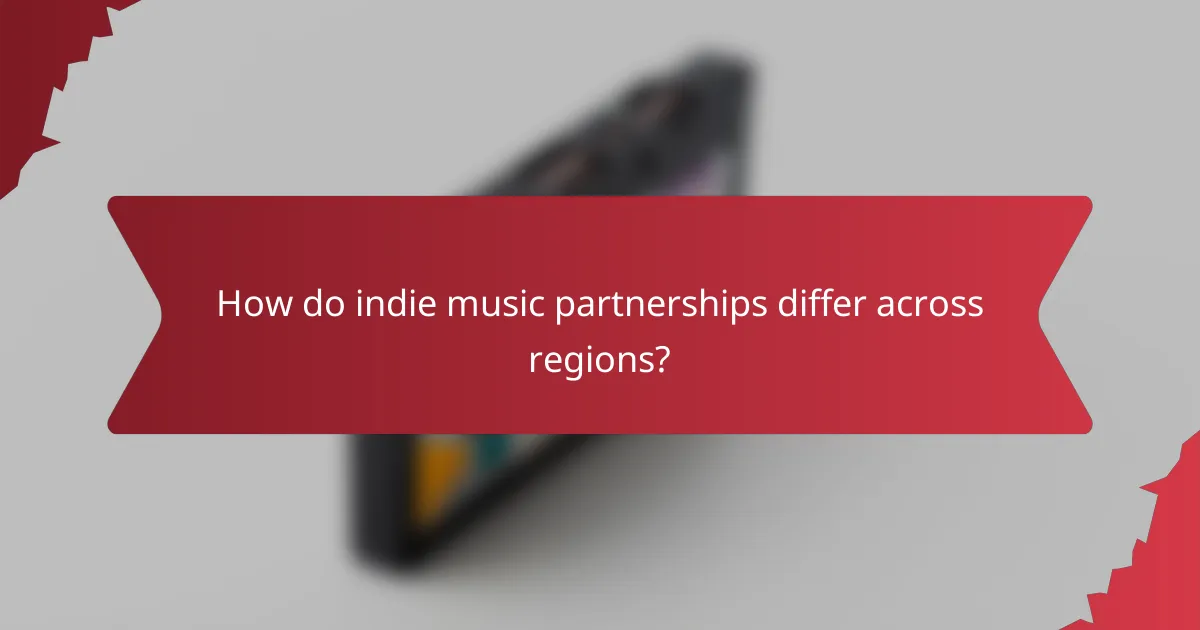
How do indie music partnerships differ across regions?
Indie music partnerships vary significantly across regions due to cultural influences and market dynamics. In North America, collaborations often focus on digital platforms and social media marketing, fostering a direct artist-to-fan relationship. In Europe, partnerships frequently involve traditional labels and live performance networks, emphasizing regional music festivals and local radio.
In Asia, indie partnerships are increasingly leveraging streaming services and mobile apps, reflecting the region’s high smartphone penetration. South America showcases vibrant local scenes that prioritize community engagement and grassroots marketing strategies. Each region’s unique attributes shape how indie artists collaborate, influencing their success in the global market.
What unique challenges do artists face in North America?
Artists in North America face unique challenges including financial instability, market saturation, and limited access to resources. These factors often hinder their ability to thrive in a competitive landscape. The rise of digital platforms has created opportunities but also intensified competition, making it difficult for indie artists to stand out. Additionally, navigating industry partnerships and securing fair contracts presents ongoing hurdles. As a result, many artists must adapt their strategies to succeed amidst these challenges.
How do cultural influences shape partnerships in Europe?
Cultural influences significantly shape partnerships in Europe by impacting collaboration styles and communication methods. Diverse musical traditions foster unique partnerships in the indie music scene. For example, artists from different countries often blend genres, creating innovative sounds. This cross-cultural collaboration enhances creativity and audience reach. Additionally, regional festivals and events encourage networking, leading to successful partnerships. As a result, cultural diversity becomes a catalyst for growth within the indie music industry.
Which trends are emerging in the Asian indie music scene?
Emerging trends in the Asian indie music scene include increased collaboration among artists, a rise in digital platforms for distribution, and a growing focus on cultural authenticity. These trends reflect a shift towards community-driven projects and innovative marketing strategies that engage local audiences. Collaborations often blend genres, showcasing diverse musical influences. Digital platforms enable wider reach and accessibility, allowing indie artists to connect with global listeners. Cultural authenticity resonates strongly, as artists draw inspiration from their heritage, creating unique sounds that reflect their identities.
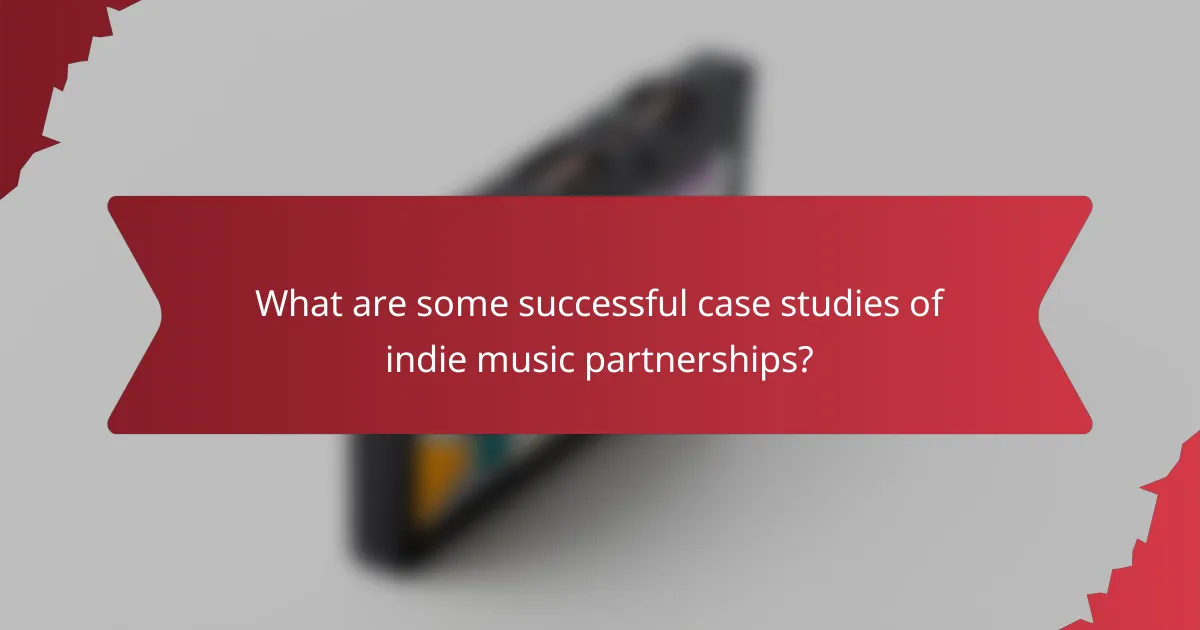
What are some successful case studies of indie music partnerships?
Indie music partnerships have led to notable success stories, showcasing innovative collaborations. One example is the partnership between Chance the Rapper and independent label Coloring Book, which gained Grammy recognition without traditional distribution. Another case is the collaboration between the band Twenty One Pilots and Fueled by Ramen, which propelled their album Blurryface to mainstream success. Additionally, the partnership between indie artist Billie Eilish and producer Finneas O’Connell exemplifies how creative synergy can lead to multiple chart-topping hits. These cases highlight the potential of indie partnerships to disrupt traditional music industry models.
Which collaborations have significantly impacted artist careers?
Collaborations that have significantly impacted artist careers include partnerships that enhance exposure and creative growth. Notable examples are the collaboration between Bon Iver and Kanye West, which elevated Bon Iver’s profile, and the partnership between Billie Eilish and her brother Finneas, which shaped her unique sound. These alliances often lead to increased streaming numbers and critical acclaim, demonstrating the power of collaboration in indie music. Artists who strategically collaborate can access new audiences and benefit from shared creativity, ultimately advancing their careers.
What lessons can be learned from notable indie labels?
Notable indie labels demonstrate key lessons in collaboration, artist development, and market adaptability. They emphasize the importance of building strong partnerships with artists, allowing creative freedom, and leveraging digital platforms for distribution. For instance, labels like Sub Pop and XL Recordings have successfully nurtured unique sounds while maintaining a loyal fan base. Their focus on community engagement and innovative marketing strategies sets a benchmark for emerging labels. Additionally, these labels highlight the significance of understanding industry trends and consumer behavior to stay relevant in a competitive landscape.

How do technology and platforms facilitate indie music partnerships?
Technology and platforms significantly enhance indie music partnerships by providing tools for collaboration, distribution, and promotion. Digital platforms like Bandcamp and SoundCloud enable artists to share their work widely, while social media facilitates connections with fans and other musicians. Data analytics tools help indie artists understand audience preferences, optimizing their marketing strategies. Additionally, crowdfunding platforms allow for financial support directly from fans, fostering a deeper artist-fan relationship. These elements collectively empower indie musicians to thrive in a competitive landscape.
Which digital tools are essential for collaboration?
Essential digital tools for collaboration in indie music partnerships include communication platforms, project management software, file-sharing services, and social media. These tools enhance connectivity, streamline workflows, and facilitate creative collaboration. Key examples are Slack for communication, Trello for project management, Dropbox for file sharing, and Instagram for promotion. Using these tools can significantly improve collaboration efficiency and foster successful partnerships in the indie music industry.
How do streaming services support partnership growth?
Streaming services enhance partnership growth for indie music by providing exposure, distribution, and audience engagement. Platforms like Spotify and Apple Music facilitate collaborations between artists and brands, creating unique promotional opportunities. These partnerships often lead to increased listener bases and revenue streams. Successful case studies include artists leveraging playlists for visibility, resulting in significant growth metrics.
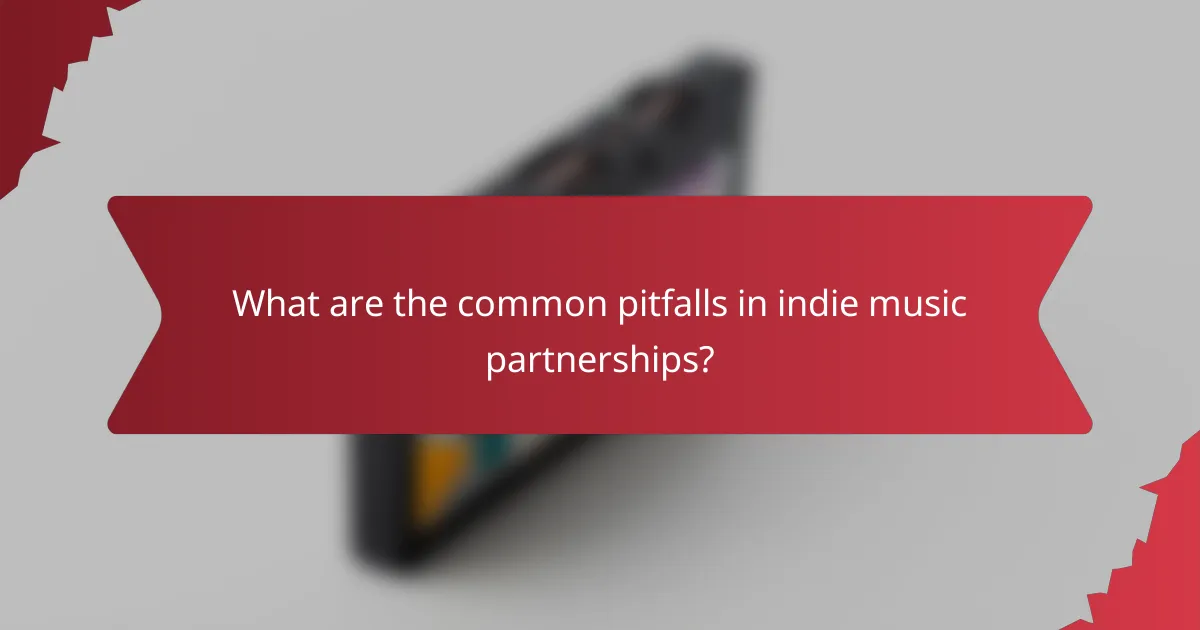
What are the common pitfalls in indie music partnerships?
Common pitfalls in indie music partnerships include misaligned goals, lack of clear communication, and inadequate contractual agreements. These issues can lead to misunderstandings and hinder collaborative success. For instance, partners may have different visions for a project, causing friction. Additionally, poor communication can result in missed deadlines and unmet expectations. Finally, without solid contracts, disputes may arise over revenue sharing or creative control, jeopardizing the partnership’s longevity. Addressing these pitfalls is essential for fostering successful indie music collaborations.
How can misaligned goals affect collaboration outcomes?
Misaligned goals can severely hinder collaboration outcomes in indie music partnerships. When partners have differing objectives, it leads to confusion, reduced motivation, and ineffective communication. This misalignment can result in missed opportunities and subpar project results. For example, if one artist prioritizes creative expression while another focuses on commercial success, their collaboration may struggle to achieve a cohesive vision. Ultimately, clear alignment on goals fosters better synergy and enhances the chances of success in the competitive indie music landscape.
What are the risks of financial dependency on partnerships?
Financial dependency on partnerships in indie music can lead to risks such as loss of creative control, financial instability, and diminished negotiation power. These risks arise when artists rely heavily on partners for funding or distribution. As a result, artists may face challenges in maintaining their artistic vision and financial independence. Additionally, partnerships can create unequal power dynamics, where one party may benefit disproportionately. Understanding these risks is crucial for indie artists when forming collaborations.

What future trends are shaping indie music partnerships?
Indie music partnerships are increasingly shaped by digital innovation, collaborative platforms, and audience engagement strategies. Artists leverage social media and streaming services to form alliances, enhancing visibility and reach.
Data shows that 70% of indie artists collaborate with brands for mutual promotion, reflecting a growing trend toward strategic partnerships. Additionally, unique collaborations across genres are becoming common, allowing artists to tap into diverse fan bases.
As a result, indie music partnerships are evolving into dynamic networks, driving creativity and expanding market opportunities. The future will likely see more emphasis on community-driven initiatives and direct fan involvement in project funding and promotion.
How is the rise of social media influencing collaboration strategies?
The rise of social media significantly enhances collaboration strategies in indie music partnerships. Artists leverage platforms to connect, share resources, and promote joint projects. This digital connectivity accelerates networking and fosters innovative collaborations, expanding audience reach. Social media analytics provide insights into listener preferences, guiding partnership decisions. As a result, indie musicians can create more targeted and successful collaborations.
What impact does globalization have on local indie scenes?
Globalization positively impacts local indie scenes by expanding their reach and collaboration opportunities. Indie artists gain access to international audiences and diverse influences, enhancing creativity. Partnerships with global brands and platforms facilitate marketing and distribution, leading to increased visibility. However, local authenticity may be challenged, as global trends can overshadow unique local sounds.
Which innovative partnership models are emerging in 2025?
Innovative partnership models in indie music are focusing on collaborative platforms and technology integration in 2025. These models emphasize co-creation between artists and brands, leveraging social media for audience engagement. Noteworthy trends include revenue-sharing agreements and community-supported initiatives, which enhance artist visibility and sustainability. As a result, indie musicians are increasingly forming alliances with tech companies to access new distribution channels and audience data.
What best practices should artists follow for successful collaborations?
Artists should prioritize clear communication, mutual respect, and shared goals for successful collaborations. Establishing a strong foundation fosters creativity and ensures all parties are aligned.
Building a diverse network enhances opportunities. Collaborating with artists from various genres can lead to innovative sounds and broaden audience reach.
Setting defined roles and responsibilities prevents misunderstandings. Each artist should know their contributions to the project, which streamlines the creative process.
Regular feedback sessions maintain momentum. Open discussions about progress and challenges encourage adaptability and strengthen the partnership.
